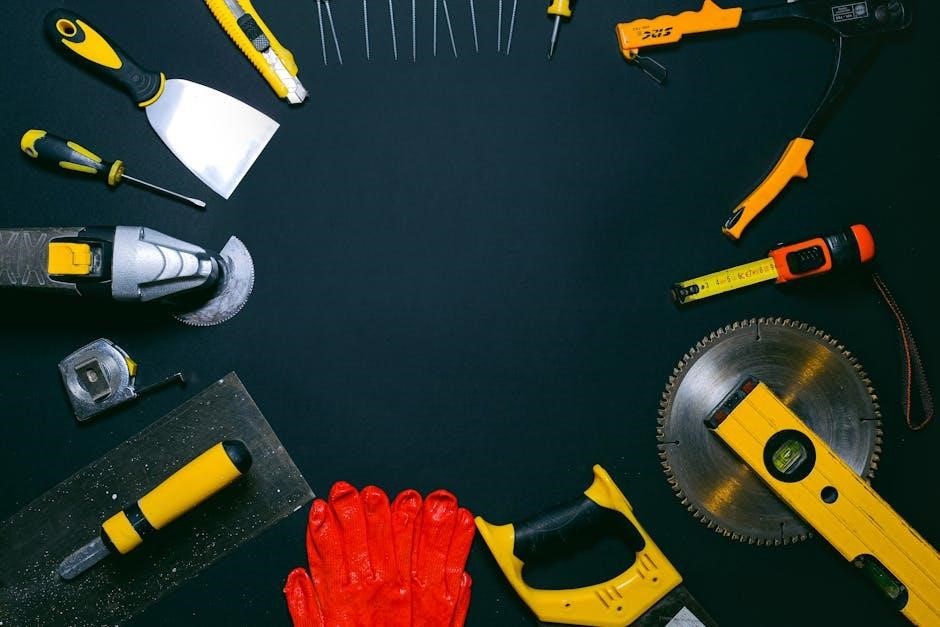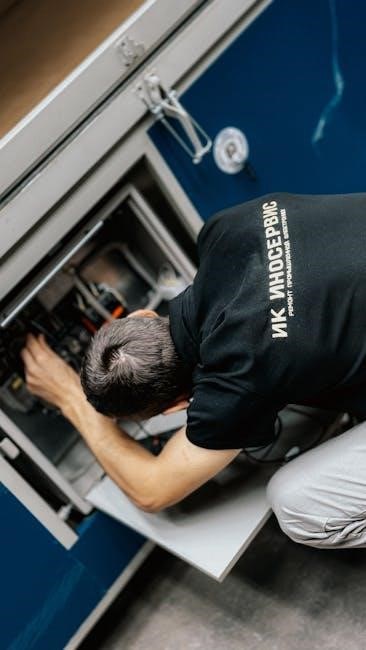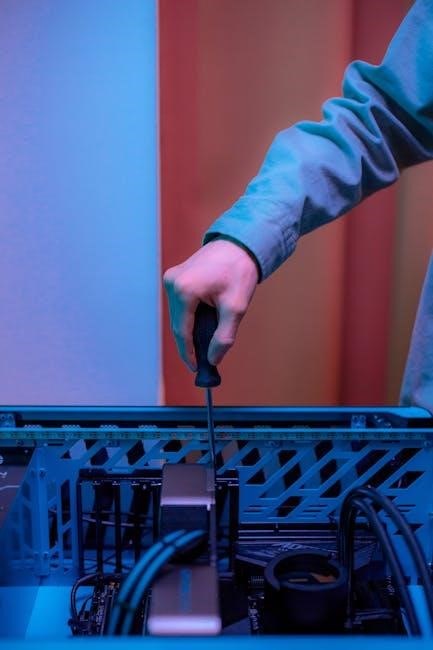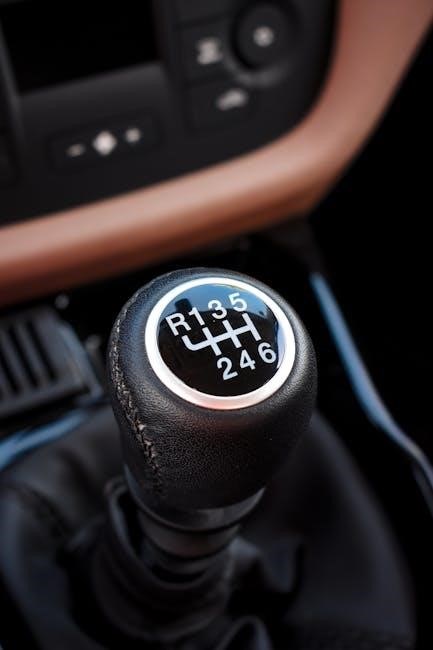The Bigfoot Leveling System is a hydraulic, automatic leveling solution designed for RVs, campers, and trailers. Known for its efficiency and stability, it ensures a smooth setup on uneven terrain. Popular among RV enthusiasts, this system offers advanced features, durability, and ease of use. Its design caters to various setups, from small trailers to large motorhomes, providing reliable performance. This manual guides users through installation, maintenance, and troubleshooting, ensuring optimal functionality and safety.
Features and Benefits
The Bigfoot Leveling System offers a range of innovative features designed to enhance stability, convenience, and safety for RVs, campers, and trailers. Key features include automatic leveling, a user-friendly control panel with sensors, and compatibility with various vehicle sizes and configurations. The system supports 4-point, 6-point, and 2-point leveling options, ensuring versatility for different setups. Its hydraulic design provides smooth and precise adjustments, while the universal mounting brackets allow easy installation on most frames.
- Automatic Leveling: Quickly stabilizes the vehicle with minimal effort.
- Advanced Sensors: Accurately detect and adjust to ground variance.
- Durable Construction: Built to withstand harsh outdoor conditions.
- Adaptability: Suitable for small trailers to large motorhomes.
- Manual Override Option: Provides control during system calibration or troubleshooting.
These features ensure a stable and level surface, reducing the risk of damage and improving safety. The system’s ease of use and robust design make it a reliable choice for outdoor enthusiasts and professionals alike.

Components and Tools
The Bigfoot Leveling System consists of several key components essential for its operation. These include hydraulic cylinders, weld-on mounting brackets, control panels, and sensors for automatic leveling. The system also comes with wiring harnesses, hydraulic hoses, and electrical controls for seamless integration with your vehicle’s battery and electrical system. Additional tools required for installation and maintenance may include a hand wrench, air tools, and a 4/6 gauge wire for grounding.
- Hydraulic Cylinders: Provide the lifting force needed to level the vehicle.
- Weld-On Brackets: Ensure secure attachment to the vehicle frame.
- Control Panel: Houses the system’s sensors and control logic for automatic operation.
- Hydraulic Hoses and Wiring: Connect components and ensure proper fluid and electrical flow.
- Limit Switch Assembly: Requires annual maintenance, including re-greasing, to maintain functionality.
These components work together to provide a stable and level surface, ensuring safety and convenience for users. Proper installation and maintenance of these parts are crucial for optimal performance.

Safety Precautions
When working with the Bigfoot Leveling System, it is essential to follow all safety guidelines to avoid accidents and ensure proper functionality. Always refer to the manual for specific precautions, as improper installation or operation can lead to system failure or personal injury.
- Warning Symbols: The manual uses international hazard symbols, including Danger, Caution, and Warning, to indicate potential risks. Understand these symbols before proceeding with any task.
- Electrical and Hydraulic Safety: Avoid overloading the system and ensure all electrical connections are secure. Hydraulic lines should be checked for leaks and damage before operation.
- Proper Grounding: Install a separate ground wire (4/6 gauge) directly to the battery to prevent electrical issues and ensure safe operation.
- Annual Maintenance: Regularly inspect and maintain components like the limit switch assembly, re-greasing as needed to prevent mechanical failure.
By adhering to these precautions, users can enjoy a safe and reliable leveling experience. Always prioritize safety to protect both the system and the operator.
Installation Instructions
Start by planning the installation and gathering all necessary tools. Unpack and inventory all components, ensuring nothing is missing. Place the system components carefully, following the manual’s layout guide. Connect the hydraulic hoses and electrical wires securely, avoiding twists or kinks. Test the system thoroughly before finalizing the setup to ensure proper functionality.
- Ensure the workspace is clean and clear of obstructions.
- Follow the manual’s specific guidelines for each step.
- Double-check all connections before powering up the system.
Proper installation is crucial for optimal performance and safety.
5.1 Pre-Installation Checks
Before starting the installation of the Bigfoot Leveling System, conduct a thorough pre-installation check to ensure a smooth process. First, verify that all components are included in the kit and free from damage. Inspect the RV’s chassis and leveling system mounting points for any existing damage or corrosion. Ensure the system is compatible with your RV’s make and model by cross-referencing the manual. Check the ground surface where the system will be installed to confirm it is level and stable. Clear the area of debris or obstructions that could interfere with the installation. Review the installation manual thoroughly and ensure all necessary tools are available. Test the hydraulic and electrical systems of your RV to ensure they are functioning properly before integrating the Bigfoot Leveling System. Finally, consult a professional if you are unsure about any aspect of the process. Proper preparation is key to a successful and safe installation.
- Verify all components are undamaged and compatible.
- Inspect the RV’s chassis and mounting points.
- Ensure the ground surface is level and clear.
- Review the manual and gather necessary tools.
- Test RV systems before installation.
A thorough pre-installation check ensures a safe and efficient setup process.
5.2 Automatic Leveling System Installation
Installing the Bigfoot Automatic Leveling System requires careful attention to detail to ensure proper functionality. Begin by unpacking and organizing all components, including the control panel, sensors, and hydraulic lines. Locate the designated mounting points on your RV’s chassis, as specified in the manual. Secure the automatic leveling sensors to these points, ensuring they are properly aligned and tightened. Next, connect the hydraulic lines to the system’s pump and valves, following the routing diagram provided. Connect the electrical connections to the RV’s power supply and control panel, double-checking for tightness and correct polarity. Once all components are installed, power on the system and run a test cycle to ensure it levels the RV evenly. Finally, verify that all sensors and hydraulic systems are functioning correctly before finalizing the installation. Always follow the manufacturer’s guidelines for torque specifications and electrical connections to avoid system malfunction. Proper installation ensures safe and efficient leveling for your RV.
- Mount sensors and components per the manual’s instructions.
- Connect hydraulic and electrical systems carefully.
- Test the system to ensure proper operation.
Accurate installation ensures optimal performance and safety.
5.3 Manual Leveling System Installation
Installing the Bigfoot Manual Leveling System involves a straightforward process that relies on mechanical adjustments rather than automatic controls. Begin by gathering all necessary tools and components, including leveling blocks, wrenches, and the system’s manual. Locate the RV’s stabilizer jacks and ensure the area is level and firm. Attach the manual leveling components to the jacks, following the manufacturer’s torque specifications. Use leveling blocks or pads under the jacks to achieve initial stability. Manually raise or lower each jack to level the RV, checking with a bubble level or electronic leveling tool. Once the RV is stable, secure the jacks in place and test the system by walking around the vehicle to ensure even ground contact. For accuracy, repeat the process until the RV is perfectly level. Always refer to the manual for specific torque values and installation guidelines to prevent over-tightening or misalignment. Proper installation ensures reliable performance and safety.
- Attach manual leveling components to stabilizer jacks.
- Use leveling blocks for initial stability.
- Adjust jacks manually to achieve even leveling.
Manual leveling requires patience and careful adjustments for optimal results;

Maintenance and Troubleshooting
Regularly lubricate moving parts, inspect for wear, and check hydraulic fluid levels. Troubleshoot issues like system malfunction by verifying electrical connections and fluid pressure. Address problems promptly to ensure optimal performance and safety.
- Lubricate moving components.
- Inspect for wear and damage.
- Check fluid levels and connections.
Proper upkeep prevents system failure and enhances reliability.
6.1 Routine Maintenance
Regular maintenance is essential to ensure the Bigfoot Leveling System operates efficiently and safely. Start by inspecting all components for signs of wear, corrosion, or damage. Check the hydraulic hoses, cylinders, and connections for leaks or cracks. Lubricate all moving parts, such as pivot pins and bushings, to prevent friction and premature wear.
Next, examine the system’s electrical connections to ensure they are secure and free from corrosion. Verify that the hydraulic fluid level is within the recommended range and top it off if necessary. Always use the type of fluid specified in the manual to maintain system performance and longevity.
- Inspect hydraulic hoses and cylinders for leaks or damage.
- Lubricate pivot pins and bushings regularly.
- Check electrical connections for security and corrosion.
- Monitor hydraulic fluid levels and use the recommended type.
By following these routine maintenance steps, you can prevent system damage, reduce downtime, and ensure optimal leveling performance.
6.2 Common Issues and Solutions
While the Bigfoot Leveling System is reliable, occasional issues may arise. One common problem is hydraulic fluid leakage, which can be resolved by inspecting hoses and connections for damage or loose fittings. Tightening or replacing worn parts will typically fix the issue. Another issue is uneven leveling, often caused by improper calibration or obstructed sensors. Restarting the system or recalibrating the sensors usually corrects this.
- Hydraulic Leaks: Inspect hoses and connections; tighten or replace damaged parts.
- Uneven Leveling: Recalibrate sensors or check for obstructions.
- Control Panel Errors: Reset the system or update software if necessary.
- Slow Operation: Check hydraulic fluid levels and ensure all valves are open.
Addressing these issues promptly ensures the system functions smoothly and maintains your RV’s stability. Always refer to the manual for specific troubleshooting steps.

Programming and Calibration
Programming and calibration are essential for ensuring the Bigfoot Leveling System operates accurately. Begin by entering your RV’s specifications, such as axle weight and suspension type, into the control panel. Calibration involves synchronizing the system with your RV’s tilt and leveling capabilities. Use a spirit level to verify the system’s accuracy during setup.
- Initial Setup: Input RV weight distribution and axle ratings.
- Calibration Process: Follow on-screen instructions to synchronize the system.
- Testing: After calibration, test the system on a level surface to ensure accuracy.
Regular recalibration is recommended after modifications or repairs. If issues arise, reset the system or consult the manual for advanced calibration steps. Proper programming ensures precise leveling and optimal system performance, enhancing safety and stability for your RV.
Wiring and Controls
The Bigfoot Leveling System requires precise wiring and control setup to function effectively. The system includes a control panel, sensors, and wiring harnesses that must be connected according to the manual’s specifications. Ensure all connections are secure and protected from moisture and vibration.
- Control Panel: Mount the panel in an accessible location, ideally near the driver’s station.
- Wiring Harness: Connect sensors, motors, and the control panel as outlined in the wiring diagram.
- Power Supply: Ensure the system is connected to a dedicated 12V power source with appropriate fuses.
- Sensors: Install leveling and tilt sensors to provide accurate data to the control system.
Test all connections before operation. Use the control panel to cycle through the system’s functions and verify proper response. Proper wiring ensures seamless communication between components, allowing for precise leveling and stabilization. Always follow safety guidelines and consult a professional if unsure about electrical connections.
For advanced setups, consider integrating the system with other RV controls or adding a touchscreen interface for enhanced convenience.

Advanced Features
The Bigfoot Leveling System offers several advanced features designed to enhance functionality and user experience; One notable feature is the auto-leveling mode, which automatically adjusts the system to achieve perfect leveling with minimal input. Additionally, the system includes memory settings, allowing users to save preferred leveling configurations for frequent campsites or setups.
- Remote Control Operation: Control the leveling process from a distance using the optional remote control, ensuring convenience and ease of use.
- Integrated Stability Sensors: Advanced sensors monitor the system’s performance, providing real-time feedback and ensuring precise leveling even on uneven terrain.
- Automatic Re-Leveling: The system can re-level automatically if minor ground shifts occur, maintaining stability without user intervention.
- Customizable Presets: Users can program specific leveling profiles for different scenarios, such as sloped driveways or uneven surfaces.
These advanced features make the Bigfoot Leveling System highly adaptable and user-friendly, catering to both novice and experienced RV owners. Regular updates and compatibility with modern RV technologies further enhance its performance and reliability.

Common Mistakes to Avoid
When using the Bigfoot Leveling System, it’s important to avoid common mistakes that could compromise performance or damage the system. One of the most frequent errors is not performing pre-installation checks, such as ensuring the ground is firm and level. Another mistake is overloading the system by exceeding the weight capacity, which can lead to mechanical failure. Users should also avoid ignoring routine maintenance, as neglecting to clean and lubricate moving parts can cause wear and tear.
- Not following calibration instructions: Improper calibration can result in inaccurate leveling and system malfunctions.
- Using the system on soft or uneven ground: This can cause instability and put additional strain on the components.
- Manually adjusting the jacks without disengaging the auto-leveling feature: This can damage the system or lead to incorrect leveling.
Avoiding these common mistakes ensures optimal performance, extends the lifespan of the system, and enhances safety. Always refer to the manual for specific guidelines and recommendations.

System Comparison
The Bigfoot Leveling System stands out among its competitors due to its durability, ease of use, and advanced features. Compared to other leveling systems, Bigfoot offers superior stability and precision, making it ideal for uneven terrain. While other systems may require manual adjustments, Bigfoot’s automatic leveling feature streamlines the process, saving time and effort.
- Durability: Bigfoot systems are built with heavy-duty materials, outlasting many competitors in harsh conditions.
- Ease of Use: The automatic leveling function is a significant advantage over manual systems that require physical effort.
- Compatibility: Bigfoot systems are designed to work seamlessly with various RV and trailer models, offering versatility.
- Cost: While often priced higher than some alternatives, Bigfoot’s longevity and performance justify the investment.
Overall, the Bigfoot Leveling System is a top choice for those seeking reliability and convenience, though budget-conscious users may explore more affordable options. Its robust design and user-friendly features make it a standout in the market. Always compare systems based on your specific needs and preferences to make an informed decision.
The Bigfoot Leveling System is a reliable and efficient solution for ensuring stability and balance in RVs and trailers. With its robust design and user-friendly features, it simplifies the leveling process, making it ideal for both novice and experienced users. The system’s durability and compatibility with various models make it a top choice for outdoor enthusiasts.
This manual has provided a comprehensive guide to understanding, installing, and maintaining the Bigfoot Leveling System. By following the instructions and safety precautions outlined, users can ensure optimal performance and extend the system’s lifespan. Whether you’re on a quick camping trip or an extended adventure, the Bigfoot Leveling System delivers the stability and peace of mind you need.
Remember to always follow the recommended maintenance routines and troubleshooting tips to keep your system in prime condition. With proper care, the Bigfoot Leveling System will continue to provide reliable service for years to come. Happy camping!

References
The information provided in this manual is based on the official Bigfoot Leveling System documentation and user guides. For further details, refer to the following sources:
- Bigfoot Leveling System Official Website: https://www.bigfootleveling.com
- Bigfoot Leveling System User Manual (Model BF5000)
- RV Leveling System Comparison Guide by RV Experts
- RV Tech Tips and Tricks Blog
- Customer Support Documentation (Bigfoot Leveling System)
Additional resources, including video tutorials and troubleshooting guides, can be found on the manufacturer’s website. Always consult the official manual for model-specific instructions. For any queries, contact Bigfoot Leveling System customer support at support@bigfootleveling.com.

Contact Information
For any inquiries, support, or technical assistance regarding the Bigfoot Leveling System, please contact the manufacturer directly using the following information:
- Website: https://www.bigfootleveling.com
- Phone: 1-800-555-LEVEL (1-800-555-5383)
- Email: support@bigfootleveling.com
- Address: Bigfoot Leveling System, 123 RV Solutions Drive, Spokane, WA 99212
Customer support is available Monday through Friday, 8:00 AM to 5:00 PM PST. For urgent matters, please visit the support portal on the official website for live chat assistance. When contacting support, have your system model and serial number ready for faster service. The Bigfoot Leveling System team is dedicated to providing prompt and effective solutions to ensure optimal performance of your leveling system.
